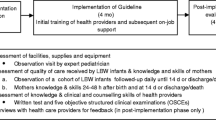Abstract
Objective
To compare the impact of postnatal lactational counseling on the weight gain and frequency of mixed feeding in full term neonates.
Design
Observational study.
Setting
Mother-infant pairs were observed in the maternity section of a multispecialty general hospital in Mumbai during two time periods.
Participants
260 mothers who delivered a full term, healthy, appropriate for gestational age neonate with birth weight >2.2 kg.
Methods
Between 18 November, 2007 and 4 March, 2008, 126 mothers received unstructured verbal encouragement to maintain breastfeeding from the maternity staff. From 1 June, 2008 to 16 December, 2008, 134 mothers were counseled about breastfeeding by the pediatric residents and nurses with the help of charts, literature and verbal advice. They were supervised and helped during the first feed and subsequently until discharge.
Main outcome measure
Weight gain (g/kg/day) of neonate at 28 days of life.
Results
The mean (SD) weight gain was significantly higher in the counseled group in comparison to historical control group [9.2 (4.5) g/kg/d vs. 7.9 (5.1) g/kg/d; P=0.03]. Mixed feeding occurred less frequently in [RR 0.36, 95% CI 0.13, 0.98; P=0.046] the counseled group (5/134) as compared to control group (13/126).
Conclusions
Postnatal lactational counseling leads to higher weight gain, and lesser chances of mixed feeding in the neonatal period.
Similar content being viewed by others
References
National Guidelines on Infant and Young Child Feeding. Ministry of Women and Child Development (Food and Nutrition Board). Second edition 2006; p.13. Available from: http://wcd.nic.in/publication/infantandyoung childfeed.pdf. Accessed October 25, 2014.
Physiologic Impact of Breastfeeding. In: Lawrence RA, Lawrence RM Breastfeeding: A Guide for Medical Professionals. 5th ed. Missouri: Mosby, Inc. 1999;197–216
How Breastfeeding Should Begin. In: King FS Helping mother’s to Breastfeed. Revised Edition. Indian Adaptation by RK Anand, Mumbai: Association for Consumers Action on Safety and Health (ACASH) 1992.
Recommendations of the Special Committee of Indian Academy of Pediatrics on Breastfeeding. Indian Pediatr. 1988;25:873–4.
American Academy of Pediatrics Work Group on Breastfeeding. Breastfeeding and the Use of Human Milk. Pediatrics. 1997;100:1035–9.
Infant and Young Child Feeding Chapter, Indian Academy of Pediatrics. Infant and Young Child Feeding Guidelines: 2010. Indian Pediatr. 2010;47:995–1004.
The World Breastfeeding Trends initiative WBTi. Are our infants falling through the Gap The State of Policies and Programme Implementation of the Global strategy for Infant and Young Child Feeding in 51 Countries. BPNI/IBFAN Asia. 2012. Available from: http://www.worldbreastfeedingtrends.org/report/WBTi-India-2012.pdf. Accessed October 25, 2014.
Lauer JA, Betran AP, Barros AJ, De Onis M. Deaths and years of life lost due to suboptimal breast feeding among children in the developing world: A global ecological risk assessment. Public Health Nutr. 2006;9:673–85.
Protecting, Promoting and Supporting Breastfeeding: The Special Role of Maternity services. A Joint WHO/UNICEF Statement. Geneva. WHO; 1989. Available from:http://apps.who.int/iris/bitstream/10665/39679/1/9241561300.pd. Accessed October 25, 2014.
Marrow A, Guerrero M, Shults J, Calva J, Lutter C, Bravo J, et al. Efficacy of home-based peer counseling to promote exclusive breastfeeding: A randomized controlled trial. Lancet. 1999; 353:1226–31.
Haider R, Ashworth A, Kabir I, Hutty S. Effect of community-based peer counselors on exclusive breastfeeding practices in Dhaka, Bangladesh: A randomized controlled trial. Lancet. 2000;356:1643–47.
Valdes V, Perez A, Labbok M, Pugin E, Zambrano I, Catalan S. The impact of a hospital and clinic-based breastfeeding promotion programme in a middle class urban environment. J Trop Pediatr. 1993;39:142–51.
Morrow A. Case studies of community based Breastfeeding promotion and support. In: Community Based Strategies for Breastfeeding Promotion and Support in Developing Countries. Geneva. WHO. 2003. p.17–19. Available from: http://apps.who.int/iris/bitstream/10665/42859/1/9241591218.pdf Accessed October 25, 2014.
Bhandari N, Bahl R, Mazumdar S, Martines J, Black RE, Bhan MK. Effect of community based promotion of Exclusive breastfeeding on diarrhoeal illness and growth: A cluster randomized controlled trial. Lancet. 2003;361:1418–23.
Thakur SK, Roy SK, Paul K, Khatun M, Khatum W, Sarker D. Effect of nutrition education on exclusive breastfeeding for nutritional outcome of low birth weight babies. Eur J Clin Nutr. 2012;66;376–81.
Salariya EM, Easton PM, Cater JI. Duration of breastfeeding after early initiation and frequent feeding. Lancet. 1978;2:1141–3.
Author information
Authors and Affiliations
Corresponding author
Rights and permissions
About this article
Cite this article
Pereira, N.M., Verma, R.J. & Kabra, N.S. Postnatal lactational counseling and neonatal weight pattern. Indian Pediatr 52, 579–582 (2015). https://doi.org/10.1007/s13312-015-0678-y
Received:
Revised:
Accepted:
Published:
Issue Date:
DOI: https://doi.org/10.1007/s13312-015-0678-y




